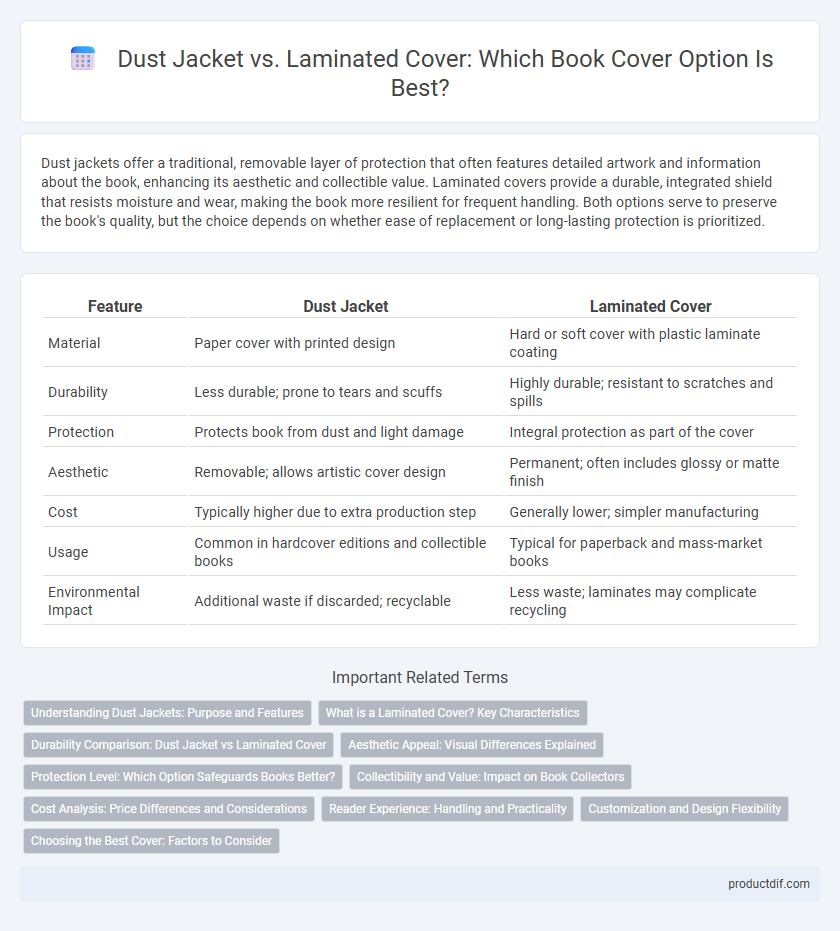Dust jackets offer a traditional, removable layer of protection that often features detailed artwork and information about the book, enhancing its aesthetic and collectible value. Laminated covers provide a durable, integrated shield that resists moisture and wear, making the book more resilient for frequent handling. Both options serve to preserve the book's quality, but the choice depends on whether ease of replacement or long-lasting protection is prioritized.
Table of Comparison
| Feature | Dust Jacket | Laminated Cover |
|---|---|---|
| Material | Paper cover with printed design | Hard or soft cover with plastic laminate coating |
| Durability | Less durable; prone to tears and scuffs | Highly durable; resistant to scratches and spills |
| Protection | Protects book from dust and light damage | Integral protection as part of the cover |
| Aesthetic | Removable; allows artistic cover design | Permanent; often includes glossy or matte finish |
| Cost | Typically higher due to extra production step | Generally lower; simpler manufacturing |
| Usage | Common in hardcover editions and collectible books | Typical for paperback and mass-market books |
| Environmental Impact | Additional waste if discarded; recyclable | Less waste; laminates may complicate recycling |
Understanding Dust Jackets: Purpose and Features
Dust jackets protect hardcover books from damage, featuring printed artwork and information like the title, author, and synopsis to attract readers and aid in marketing. Laminated covers, often found on paperbacks or trade paperbacks, provide a durable, moisture-resistant surface without the removable aspect of dust jackets. Understanding the distinct protective and promotional roles of dust jackets helps collectors and readers appreciate their functional and aesthetic value.
What is a Laminated Cover? Key Characteristics
A laminated cover is a protective layer of thin plastic film applied to the book's outer cover, enhancing durability and resistance to moisture, scratches, and general wear. This coating can be either matte or glossy, providing a smooth, finished appearance while preserving the book's original printed surface. Unlike dust jackets, laminated covers are permanently affixed, eliminating the need for an additional removable protective layer.
Durability Comparison: Dust Jacket vs Laminated Cover
Dust jackets, made of paper, offer moderate protection against dust and scratches but are prone to tearing and moisture damage, reducing overall durability. Laminated covers consist of a thin, plastic coating directly applied to the book cover, significantly enhancing resistance to wear, spills, and fading for long-lasting preservation. While dust jackets can be replaced if damaged, laminated covers provide a more robust, maintenance-free solution for sustaining the book's condition over time.
Aesthetic Appeal: Visual Differences Explained
Dust jackets often showcase intricate artwork and vivid colors printed on glossy paper, enhancing the book's visual appeal and giving it a collectible quality. Laminated covers feature a smooth, durable coating directly on the cover material, offering a sleek, modern look with subtle texture and increased resistance to wear. The choice between dust jacket and laminated cover significantly influences the book's overall aesthetic, shaping first impressions and influencing perceived value.
Protection Level: Which Option Safeguards Books Better?
Dust jackets provide a removable protective barrier that guards against dust, scratches, and minor spills, but their thin paper material can tear easily, limiting long-term durability. Laminated covers offer a more robust defense by fusing a plastic coating directly onto the book cover, enhancing resistance to moisture, stains, and wear from handling. For safeguarding books, laminated covers generally deliver superior protection by maintaining the book's structural integrity and appearance over extended periods.
Collectibility and Value: Impact on Book Collectors
Dust jackets significantly enhance a book's collectibility and value by providing original artwork, author notes, and protection against wear, often making first editions with intact dust jackets highly sought after. Laminated covers offer durability but typically lack the unique artistic and historical appeal that dust jackets provide, resulting in lower overall market desirability among collectors. The preservation of dust jackets directly correlates with increased auction prices and rarity status in the book collecting community.
Cost Analysis: Price Differences and Considerations
Dust jackets typically increase a book's production cost by 20-30% due to additional materials and printing processes, while laminated covers raise costs by approximately 10-15% through protective coating expenses. Publishers often weigh dust jacket pricing against enhanced aesthetic appeal and marketability, whereas laminated covers prioritize durability and cost efficiency. Cost-effective decisions depend on print run size, target audience, and desired shelf impact in the competitive book market.
Reader Experience: Handling and Practicality
Dust jackets offer a tactile, lightweight experience with easy removal and replacement, enhancing the book's collectible appeal while remaining vulnerable to tears and wear. Laminated covers provide durable, spill-resistant protection that withstands frequent handling but lack the delicate charm and flexibility of a dust jacket. Readers prioritizing longevity and ease of cleaning often prefer laminated covers, whereas collectors and casual readers may favor dust jackets for their aesthetic and traditional feel.
Customization and Design Flexibility
Dust jackets provide high customization options with full-bleed printing and vibrant imagery, allowing intricate designs and tailored typography to enhance a book's aesthetic appeal. Laminated covers offer durable protection with a sleek finish, supporting spot gloss, matte, or soft-touch lamination techniques that add texture and tactile contrast. Both options enable unique branding but dust jackets excel in design flexibility through removable and replaceable art, while laminated covers emphasize sturdy, long-lasting presentation.
Choosing the Best Cover: Factors to Consider
Choosing the best book cover involves evaluating durability, aesthetic appeal, and cost-effectiveness between dust jackets and laminated covers. Dust jackets offer customizable designs and protection but are prone to wear and tearing, whereas laminated covers provide a sturdy, moisture-resistant surface with vibrant, long-lasting prints. Consider the target audience, handling frequency, and storage conditions to determine the optimal cover type for preserving and showcasing the book.
Dust Jacket vs Laminated Cover Infographic

 productdif.com
productdif.com